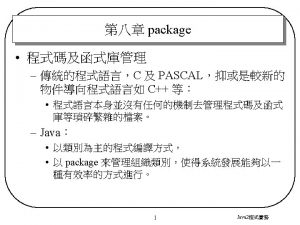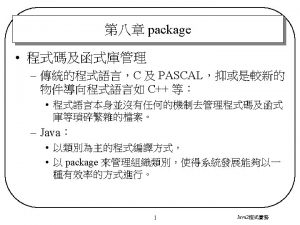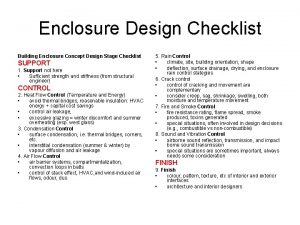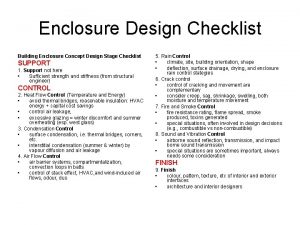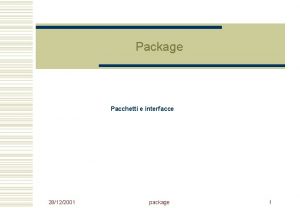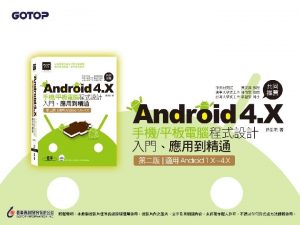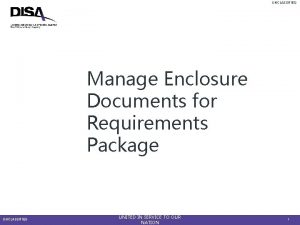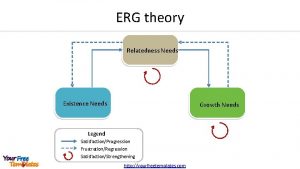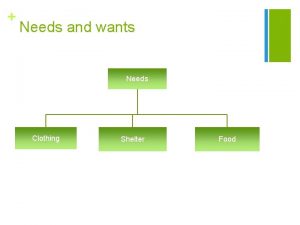External Enclosure External Enclosure Needs The external package













- Slides: 13

External Enclosure

External Enclosure • Needs – The external package should be lightweight/ robust/ water resistant – The devices should be competitive with current devices – The device should fit into a small pouch and be comfortable for user and be comfortable for the user – The external package should resist minor splashing – The device should survive a fall from the hip • Risks – – Housing for the electronics is too heavy/large/uncomfortable Water can enter the external package and harm the electronics The housing fails before the electronic components in drop tests The electronic components can not survive multiple drop tests

Concept Generation. Materials/Manufacturing Process Concept Generation- Material and Manufacturing Processes Rapid Prototyping (ABS Plastic) Selection Criteria Weight Rating Notes Score Cost 9 4 36 Feasibility within timeline 10 5 50 Strength 6 4 37 MPa 24 Material Interaction with water 4 2 8 Ease of Manufacturing 3 5 15 0 20 wires 0 Net Score 133 Rank 1 Continue? yes weight 1 - low importance 10 - high importance rating 1 - does not meet cirteria 5 - meets cirteria Stereolithography Rating Notes Score 1 9 4 long lead time 40 5 58 MPa 30 4 resin based 16 5 15 0 10 wires 0 110 2 No Injection Molded Rating Notes Score 1 $30 k for mold 9 1 10 5 35 -70 MPa 30 5 20 3 9 0 3 wires 0 78 3 no Machine Metal or Polymer Rating Notes Score 2 18 3 30 5 ~580 MPa 30 4 16 3 9 0 3 wires 0 103 4 no

Rapid Prototyping • Machinable – Material can be drilled and tapped (carefully) • Accepts CAD drawings – Complex geometries can be created easily – Ideal for proposed ergonomic shape • Builds with support layer – Models can be built with working/moving hinges without having to worry about pins • Capable of building thin geometries • ABSplus – Industrial thermoplastic • Lightweight - Specific gravity of 1. 04 • Porous – Does not address water resistant need http: //www. dimensionprinting. com/

ABS Plastic Mechanical Property Test Method Imperial Metric Tensile Strength ASTM D 638 5, 300 psi 37 MPa Tensile Modulus ASTM D 638 330, 000 psi 2, 320 MPa Tensile Elongation ASTM D 638 3% 3% Heat Deflection ASTM D 648 204°F 96°C Glass Transition DMA (SSYS) 226°F 108°C Specific Gravity ASTM D 792 1. 04 Coefficient of Thermal Expansion ASTM E 831 4. 90 E-5 in/in/F • Important Notes • Relatively high tensile strength • Glass Transition well above body temperature • Specific Gravity indicates lightweight material

Feasibility- Water Ingress Test • • Need: The external package should resist minor splashing Specification: Water Ingress Tests – Once model is constructed, (user interface, connectors sealed, lid in place) exclude internal electronics and perform test – Monitor flow rate (length of time and volume) of water – Asses the quality to which water is prevented from entering case by examining water soluble paper • • Risk: Water can enter the external package and harm the electronics Preventative measures: – Spray on Rubber Coating or adhesive – O-rings around each screw well and around the lid – Loctite at connectors • Preliminary Tests without protective coating show no traceable water ingress Loctite Spray on Rubberized Coating

Feasibility- Robustness Testing • • Need: The device should survive a fall from the hip Specification: Drop Test – – • Goal – – • Risks – – • Drop external housing 3 times from 1. 5 m, device should remain fully intact Specify and build internal electrical components Identify the “most vulnerable” electrical component(s) which may be susceptible to breaking upon a drop Mimic those components using comparable (but inexpensive and replaceable) electrical components, solder on point to point soldering board Show the housing will not fail Show electronics package will not fail, when subjected to multiple drop tests The housing fails before the electronic components in drop tests (proved unlikely with prototype enclosure) The electronic components can not survive multiple drop tests Preventative Measures – – – Eliminate snap hinges from housing (tested and failed) Test the housing first Design a compact electronics package

Feasibility- Heat Dissipation of Internal Components 130°C is absolute maximum for chip junction temperature in order to function properly Goal- comfort for the user Assumed steady state, heat only dissipated through 3 external surfaces Maximum heat dissipation ~25 W Actual heat dissipation ~5 W Tout Tin Q h 250 Internal Temperature [°C] • • • 200 Tout= Room 150 Tout = Body 100 Absolute Max Temperature 50 0 t, k 0 10 20 30 Heat Generation, Q [W] 40

Prototype Enclosure • Survived drop test • Water resistant • Plastic is machinable – Drilled, tapped, milled • Helicoils should be used to tap holes – Constant opening and screwing and unscrewing of lid will result in stripped threads • Approximate wall thickness (6 mm) • Distance between center of holes and wall needs to be increased – Some cracking occued • Latches are not feasible

User Interface To Battery MENU Speed Battery Life Fault Indication Components: Indication of battery life (3 x LED) Indication of Fault (LED and Buzzer) Indication of levitation (LED) Display Increase/Decrease Speed (2 x Button) Menu (Button) + - BATTER Y OK ERROR From Pump To/From Computer Connectors: 26 - pin LEMO connector USB connector Battery Terminals (x 2) OK: Indication of levitation ERROR: No Levitation, connection errors

User Interface- Components LED Backlit display with waterproof bezel and o-ring G/R/Y LEDs with O-ring and waterproof bezel Waterproof buttons with O-ring

User Interface- Connectors Current Model: Part # EGG 2 K 326 CLL Proposed: Part # EEG 2 K 326 CLV Pin Layout

User Interface- IP Codes IP Ingress Protection First Number Protection against Solid Objects 0 - No protection (Sometimes X) 1 - Protected against solid objects up to 50 mm³ 2 - Protected against solid objects up to 12 mm³ 3 - Protected against solid objects up to 2. 5 mm³ 4 - Protected against solid objects up to 1 mm³ 5 - Protected against dust, limited ingress (no harmful deposit) 6 - Totally protected against dust Second Number Protection against liquids 0 - No protection (Sometimes X) 1 - Protection against vertically falling drops of water (e. g. condensation) 2 - Protection against direct sprays of water up to 15 degrees from vertical 3 - Protection against direct sprays of water up to 60 degrees from vertical 4 - Protection against water sprayed from all directions - limited ingress permitted 5 - Protected against low pressure jets of water from all directions - limited ingress permitted 6 - Protected against low pressure jets of water, limited ingress permitted (e. g. ship deck) 7 - Protected against the effect of immersion between 15 cm and 1 m 8 - Protected against long periods of immersion under pressure Display IP 67 Buttons IP 67 LEDs IP 67 USB IP 68 Connector IP 68
 Simple claustral complex
Simple claustral complex Strategic gender needs and practical gender needs
Strategic gender needs and practical gender needs Primary needs and secondary needs
Primary needs and secondary needs Graves 2000
Graves 2000 Primary needs and secondary needs
Primary needs and secondary needs ưu thế lai là gì
ưu thế lai là gì Tư thế ngồi viết
Tư thế ngồi viết Môn thể thao bắt đầu bằng chữ đua
Môn thể thao bắt đầu bằng chữ đua Cái miệng bé xinh thế chỉ nói điều hay thôi
Cái miệng bé xinh thế chỉ nói điều hay thôi Hình ảnh bộ gõ cơ thể búng tay
Hình ảnh bộ gõ cơ thể búng tay Mật thư anh em như thể tay chân
Mật thư anh em như thể tay chân Tư thế ngồi viết
Tư thế ngồi viết V. c c
V. c c Voi kéo gỗ như thế nào
Voi kéo gỗ như thế nào














